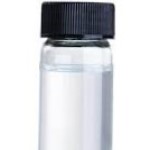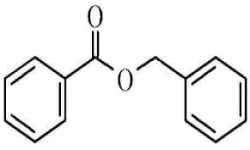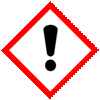CAS Number 120-51-4, Benzyl Benzoate USP BP Ph Eur IP Grade Manufacturers Exporters







CAS Number 120-51-4, Benzyl Benzoate
For Properties Specifications of Benzyl Benzoate Click Properties, Specifications of Benzyl Benzoate Manufacturer.
For Uses of aaa Click Uses of Benzyl Benzoate Manufacturer.
For For SDS MSDS Sheet of Benzyl Benzoate Click SDS Safety Data Sheet MSDS Sheet of Benzyl Benzoate Manufacturer.
The Properties and Specifications of Benzyl Benzoate:
Specifications of Benzyl Benzoate USP Grade Specifications
C14H12O2 -- 212.24 -- CAS 120-51-4.
Benzoic acid, phenylmethyl ester.
Benzyl Benzoate contains not less than 99.0 percent and not more than 100.5 percent of C14H12O2.
Identification: Infrared Absorption.
Specific gravity: between 1.116 and 1.120.
Congealing temperature: not lower than 18.0 . Congelation may be brought about by addition of a fragment of previously congealed Benzyl Benzoate when the temperature has reached the expected congealing temperature.
Refractive index: between 1.568 and 1.570 at 20 .
Aldehyde: Transfer 10.0 g to a 125-mL conical flask containing 50 mL of alcohol and 5 mL of hydroxylamine hydrochloride solution (3.5 in 100), mix, and allow to stand for 10 minutes. Add 1 mL of bromophenol blue and titrate with 0.1 N sodium hydroxide to a light green endpoint. Perform a blank determination, and match the color of the endpoint with that of the titrated test solution. The net volume of 0.1 N sodium hydroxide consumed does not exceed 0.50 mL (0.05% as benzaldehyde).
Acidity: Add 2 drops of PhPh to 25 mL of alcohol, and add 0.020 N sodium hydroxide until a pink color is produced. Add 5.0 g of Benzyl Benzoate, mix, and titrate with 0.020 N sodium hydroxide: not more than 1.5 mL of 0.020 N sodium hydroxide is required to restore the pink color.
Organic volatile impurities: meets the requirements.
Benzyl Benzoate BP Ph Eur Grade Specifications
Ph Eur
C14H12O2 -- 212.2 -- CAS 120-51-4
DEFINITION
Phenylmethyl benzoate.
Content: 99.0 per cent to 100.5 per cent.
CHARACTERS
Appearance: Colourless or almost colourless crystals or colourless or almost colourless, oily liquid.
Solubility: Practically insoluble in water, miscible with ethanol (96 per cent), with methylene chloride and with fatty and essential oils.
IDENTIFICATION
First identification A.
Second identification B, C.
A. Infrared absorption spectrophotometry (2.2.24). Comparison Ph. Eur. reference spectrum of benzyl benzoate.
B. To 2 g add 25 ml of alcoholic potassium hydroxide solution and boil under a reflux condenser for 2 h. Remove the ethanol on a water-bath, add 50 ml of water and distill. Collect about 25 ml of distillate and use it for identification test C. Acidify the liquid remaining in the distillation flask with dilute hydrochloric acid. A white precipitate is formed that, when washed with water and dried in vacuum melts at 121C to 124C.
C. To the distillate obtained in identification test B add 2.5 g of potassium permanganate and 5 ml of dilute sodium hydroxide solution. Boil under a reflux condenser for 15 min, cool and filter. Acidify the filtrate with dilute hydrochloric acid. A white precipitate is formed that, when washed with water and dried in vacuum, melts at 121C to 124C.
TESTS
Acidity: Dissolve 2.0 g in ethanol (96 per cent) R and dilute to 10 ml with the same solvent. Titrate with 0.1 M sodium hydroxide using PhPh solution R as indicator. Not more than 0.2 ml is required to change the colour of the indicator to pink.
Relative density: 1.118 to 1.122.
Refractive index: 1.568 to 1.570.
Freezing point: Minimum 17.0C.
Sulphated ash: Maximum 0.1 per cent, determined on 1.0 g.
Benzyl Benzoate JP and IP Grades is also supplied.
The Uses of Benzyl Benzoate:
Benzyl benzoate is used as a medication and insect repellent. Benzyl benzoate is used to treat lice and scabies infestations. As an insecticide/miticide, it was used to control dust mites in carpets, mattresses, upholstery, and on furniture.
The MSDS-SDS Hazard Statement of Benzyl Benzoate:
Benzyl Benzoate, SDS Safety Data Sheet
MSDS Sheet, Material Safety Data Sheet 04-Jan-22
1. PRODUCT IDENTIFICATION
Product Name & Other Names: Benzyl Benzoate
CAS Number: 120-51-4
EINECS EC Number: 204-402-9
Molecular Formula: C6H5COOCH2C6H5
Molecular Weight: 212.24
Relevant uses and uses advised against (if any): Industrial use only.
2. HAZARDS IDENTIFICATION
GHS, Globally Harmonized System Classification in accordance with 29 CFR 1910
Classification according to Regulation (EC) No 1272/2008
Acute toxicity, oral Category 4 H(302)
Hazardous to the aquatic environment, long-term hazard Category 2 (H411)
Labeling according to GHS & Regulation (EC) No 1272/2008
GHS Label Elements |
GHS Label Elements |
Signal Words: Warning
Hazard Statements:
H302: Harmful if swallowed.
H411: Toxic to aquatic life with long lasting effects.
Precautionary Statements:
P264: Wash … thoroughly after handling.
P270: Do not eat, drink, or smoke when using this product.
P273: Avoid release to the environment.
P330: Rinse mouth.
P301+312: IF SWALLOWED: Call a POISON CENTER or doctor/physician if you feel unwell. P391: Collect spillage.
3. COMPOSITION / INFORMATION ON INGREDIENTS
Product Name & Other Names: Benzyl Benzoate
CAS Number: 120-51-4
EINECS EC Number: 204-402-9
FEMA: 2138
4. FIRST-AID MEASURES
Always seek medical attention after first aid measures are provided.
Eye Contact: Rinse immediately with plenty of water for 10 minutes at least. Contact a physician if symptoms persist.
Skin Contact: Wash thoroughly with soap and water; flush with plenty of water. Take off spoilt clothes. Contact physician if symptoms persist.
Ingestion: Wash the mouth with water; seek medical advice immediately.
Inhalation: Remove from exposure site to fresh air and keep at rest. Obtain medical advice.
5. FIRE-FIGHTING MEASURES
Extinguishing Media Recommended: Use water spray, alcohol-resistant foam, dry chemical, or carbon dioxide.
Non-Recommended: Do not use direct water jet on burning material.
Extinguishing Procedure: Closed containers may build up pressure at elevated temperatures. If possible, containers should be cooled with a water spray.
Special Information: In the event of a fire, wear full protective clothing and NIOSH-approved self-contained breathing apparatus with full face piece operated in the pressure demand or other positive pressure mode. At high temperatures under fire conditions, it may produce toxic or irritating fumes.
6. ACCIDENTAL RELEASE MEASURES
Personal precautions, protective equipment, and emergency procedures: Avoid breathing dust/fumes/gas/mist/vapors/spray. Use individual protective equipment (waterproof boots, suitable protective clothing, safety glasses, etc.). Do not approach facing the wind.
Environmental precautions: Do not let the product enter drains, soil, or water sources.
Methods and materials used for containment Cleanup procedures and Storage: Contain spilled material. Cover with an inert, non-combustible absorbent material, (e.g. sand, earth, diatomaceous earth, vermiculite). Vacuum or sweep up and remove to an approved disposal container. Avoid open flames or other sources of ignition.
7. HANDLING AND STORAGE
Precautions for safe handling: Apply according to good manufacturing and industrial hygiene practices. Ensure proper ventilation. Wash thoroughly after handling. Do not drink, eat, or smoke while handling. Avoid contact with skin, eyes, and clothing. Minimize dust generation. Avoid breathing dust/fumes/gas/mist/vapors/spray. Keep container tightly closed. Avoid ingestion and inhalation. Use individual protective equipment (waterproof boots, suitable protective clothing, safety glasses, etc.).
Conditions for safe storage, including any incompatibilities: Store in cool, dry, and ventilated area away from heat sources and protected from sunlight in tightly closed original container. Keep air contact to a minimum. Do not leave the material container open. Store protected from heat, sparks and ignition sources and incompatible materials. Avoid contact with skin and eyes. Avoid inhalation of dust/mist/vapor. Do not store with incompatible materials like strong acids, alkali, or oxidizing agents. Keep air contact to a minimum. Keep away from ignition sources and naked flame.
8. EXPOSURE CONTROL
Respiratory Protection: Avoid to breath directly on the product. Apply local ventilations when appropriate.
Ventilation System: A system of local and/or general exhaust is recommended to keep employee exposures as low as possible.
Personal Respirators (NIOSH Approved): For conditions of use where exposure to dust or mist is apparent and engineering controls are not feasible, a particulate respirator may be worn.
Skin Protection: Wear protective gloves and clean body-covering clothing.
Eye Protection: Use chemical safety goggles and/or full face shield where dusting or splashing of solutions is possible. Maintain eye wash fountain and quick-drench facilities in work area.
Other Control Measures: Maintain good housekeeping in work area. Handle in accordance with good industrial hygiene and safety practice.
9. PHYSICAL AND CHEMICAL PROPERTIES
Appearance: It is colorless oily-liquid / crystalline-solid.
Odor: Light, Balsamic, Almonds-like.
Odor threshold: Not available.
pH: Not available.
Relative density: Not available.
Flash Point (C): 148C
Boiling Point (C): 323C - 325C
Melting Point (C): 18C - 19C.
Auto-ignition temperature: Not available.
Decomposition temperature: Not available.
Upper/lower flammability or explosive limits: Not available.
Vapor pressure: Not available.
Vapor density: Not available.
Evaporation rate: Not available.
Flammability (solid, gas): Not available.
Partition coefficient: n-octanol/water: Not available.
Solubility(ies): Not available.
Viscosity: Not available.
10. STABILITY AND REACTIVITY
Reactivity: It presents no significant reactivity hazards, by itself or in contact with water. Avoid contact with strong acids, alkali, or oxidizing agents.
Decomposition: Carbon monoxide and unidentified organic compounds may be formed during combustion.
11. TOXICOLOGICAL INFORMATION
LD50 Oral - rabbit - 1,680 mg/kg
LD50 Dermal - rabbit - 4,000 mg/kg
LD50 Oral - rat - 1900 mg/kg
Carcinogenicity: No component of this product present at levels greater than or equal to 0.1% is identified as probable, possible or confirmed human carcinogen by IARC, ACGIH, OSHA and NTP.
Mutagenic Effects: Not available.
Developmental Toxicity: Not available.
Reproductive Effects: No information available.
12. ECOLOGICAL INFORMATION
LC50 Fish 96 hour 2.3-3.9 mg/L Species Brachydanio rerio
Biodegradability: Readily biodegradable.
Results of PBT and vPvB assessment: This substance/mixture contains no components considered to be either persistent, bioaccumulative and toxic (PBT), or very persistent and very bioaccumulative (vPvB) at levels of 0.1% or higher.
13. DISPOSAL CONSIDERATIONS
In accordance with local environmental laws. Avoid disposing into drainage systems and into the environment.
14. TRANSPORT REGULATIONS
DOT USA & ADR/RID Europe:
UN number: 3082 Class: 9 Packing group: III
Proper shipping name: ENVIRONMENTALLY HAZARDOUS SUBSTANCE, LIQUID, N.O.S. (Benzyl benzoate).
IMDG & ADR/RID:
UN number: 3082 Class: 9 Packing group: III EMS-No: F-A, S-F
Proper shipping name: ENVIRONMENTALLY HAZARDOUS SUBSTANCE, LIQUID, N.O.S. (Benzyl benzoate).
IATA:
UN number: 3082 Class: 9 Packing group: III
Proper shipping name: Environmentally hazardous substance, liquid, n.o.s. (Benzyl benzoate)
15. REGULATORY INFORMATION
USA:
SARA 311/312 Hazards: Immediate Health Hazard. See section 2.
California Prop. 65 Components: Not listed.
Section 16 - Additional Information
Disclaimer:
****************************
Our company provides this MSDS sheet in good faith but makes no representation as to its comprehensiveness or accuracy. This SDS sheet is intended only as a guide to the appropriate precautionary handling of the material by a properly trained person using this product. The above information has been compiled from various sources and has the possibility of discrepancy and being out-dated information. Individuals receiving the information must exercise their independent judgment and do further search in determining its appropriateness for a particular purpose. In no case shall our company be liable to loss or damages by the product user.
****************************
Anmol Chemicals & Pharmaceuticals Pvt. Ltd. is an off-shoot of Anmol Chemicals Taloja. It is located in MIDC Taloja and it is manufacturing pharmaceutical grades of API, Excepients, Food grade and Reagent grade chemicals. Anmol Chemicals & Pharmaceuticals Pvt. Ltd. is a several decades old group of companies, engaged in manufacturing, supplying, distributing, wholesale supplies for actual users, retail or small pack supplies for research and development chemicals, fine and speciality chemicals, pharmaceutical excipients, mineral fortifiers in chemically pure, Analytical reagent grade, IP BP USP Ph Eur EP JP and other pharmaceutical grade monograph including FCC Food grade chemicals and Nutraceuticals, Mineral Fortifiers at best prices.

Benzyl Benzoate Structure
CAS Number120-51-4, Benzyl Benzoate Manufacturer Exporter
ANMOL CHEMICALS & PHARMACEUTICALS Pvt. Ltd.
India, USA, Europe, UAE
TELEPHONE: +912223770100
Navi Mumbai, INDIA
e-mail: info(At the rate i.e. @)anmol.org
Copyright. 3-nov-24
We manufacture:



